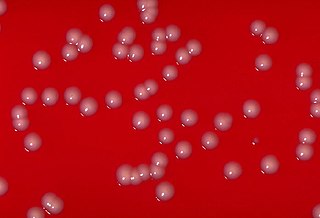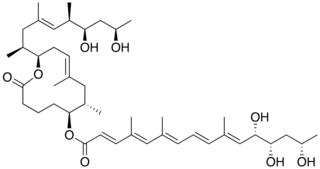
Mycoplasma genitalium is a sexually transmitted, small and pathogenic bacterium that lives on the mucous epithelial cells of the urinary and genital tracts in humans. Medical reports published in 2007 and 2015 state that Mgen is becoming increasingly common. Resistance to multiple antibiotics, including the macrolide azithromycin, which until recently was the most reliable treatment, is becoming prevalent. The bacteria was first isolated from the urogenital tract of humans in 1981, and was eventually identified as a new species of Mycoplasma in 1983. It can cause negative health effects in men and women. It also increases the risk factor for HIV spread with higher occurrences in those previously treated with the azithromycin antibiotics.

Treponema pallidum, formerly known as Spirochaeta pallida, is a microaerophilic spirochaete bacterium with subspecies that cause the diseases syphilis, bejel, and yaws. It is transmitted only among humans. It is a helically coiled microorganism usually 6–15 μm long and 0.1–0.2 μm wide. T. pallidum's lack of either a tricarboxylic acid cycle or oxidative phosphorylation results in minimal metabolic activity. The treponemes have a cytoplasmic and an outer membrane. Using light microscopy, treponemes are visible only by using dark-field illumination. T. pallidum consists of three subspecies, T. p. pallidum, T. p. endemicum, and T. p. pertenue, each of which has a distinct associated disease.

Clindamycin is a lincosamide antibiotic medication used for the treatment of a number of bacterial infections, including osteomyelitis (bone) or joint infections, pelvic inflammatory disease, strep throat, pneumonia, acute otitis media, and endocarditis. It can also be used to treat acne, and some cases of methicillin-resistant Staphylococcus aureus (MRSA). In combination with quinine, it can be used to treat malaria. It is available by mouth, by injection into a vein, and as a cream or a gel to be applied to the skin or in the vagina.

Corynebacterium diphtheriae is the pathogenic bacterium that causes diphtheria. It is also known as the Klebs–Löffler bacillus, because it was discovered in 1884 by German bacteriologists Edwin Klebs (1834–1912) and Friedrich Löffler (1852–1915). The bacteria are usually harmless unless they are infected by a bacteriophage that carries a gene that gives rise to a toxin. This toxin causes the disease. Diphtheria is caused by the adhesion and infiltration of the bacteria into the mucosal layers of the body, primarily affecting the respiratory tract and the subsequent release of an endotoxin. The toxin has a localized effect on skin lesions, as well as a metastatic, proteolytic effects on other organ systems in severe infections. Originally a major cause of childhood mortality, diphtheria has been almost entirely eradicated due to the vigorous administration of the diphtheria vaccination in the 1910s.

Corynebacterium is a genus of Gram-positive bacteria and most are aerobic. They are bacilli (rod-shaped), and in some phases of life they are, more specifically, club-shaped, which inspired the genus name.

Staphylococcus haemolyticus is a member of the coagulase-negative staphylococci (CoNS). It is part of the skin flora of humans, and its largest populations are usually found at the axillae, perineum, and inguinal areas. S. haemolyticus also colonizes primates and domestic animals. It is a well-known opportunistic pathogen, and is the second-most frequently isolated CoNS. Infections can be localized or systemic, and are often associated with the insertion of medical devices. The highly antibiotic-resistant phenotype and ability to form biofilms make S. haemolyticus a difficult pathogen to treat. Its most closely related species is Staphylococcus borealis.

Pseudomonas aeruginosa is a common encapsulated, Gram-negative, aerobic–facultatively anaerobic, rod-shaped bacterium that can cause disease in plants and animals, including humans. A species of considerable medical importance, P. aeruginosa is a multidrug resistant pathogen recognized for its ubiquity, its intrinsically advanced antibiotic resistance mechanisms, and its association with serious illnesses – hospital-acquired infections such as ventilator-associated pneumonia and various sepsis syndromes. P. aeruginosa is able to selectively inhibit various antibiotics from penetrating its outer membrane - and has high resistance to several antibiotics, according to the World Health Organization P. aeruginosa poses one of the greatest threats to humans in terms of antibiotic resistance.

Burkholderia pseudomallei is a Gram-negative, bipolar, aerobic, motile rod-shaped bacterium. It is a soil-dwelling bacterium endemic in tropical and subtropical regions worldwide, particularly in Thailand and northern Australia. It was reported in 2008 that there had been an expansion of the affected regions due to significant natural disasters, and it could be found in Southern China, Hong Kong, and countries in America. B. pseudomallei, amongst other pathogens, has been found in monkeys imported into the United States from Asia for laboratory use, posing a risk that the pathogen could be introduced into the country.

Mycolactone is a polyketide-derived macrolide produced and secreted by a group of very closely related pathogenic mycobacteria species including M. ulcerans, M. liflandii, M. pseudoshottsii, and some strains of M. marinum. These mycobacteria are collectively referred to as mycolactone-producing mycobacteria or MPM.
Corynebacterium amycolatum is a gram-positive, non-spore-forming, aerobic or facultatively anaerobic bacillus capable of fermentation with propionic acid as the major end product of its glucose metabolism. One of its best known relatives is Corynebacterium diphtheriae, the causative agent of diphtheria. C. amycolatum is a common component of the natural flora found on human skin and mucous membranes, and therefore is an occasional contaminant in human blood cultures but can rarely cause infections such as endocarditis.
Methylocella silvestris is a bacterium from the genus Methylocella spp which are found in many acidic soils and wetlands. Historically, Methylocella silvestris was originally isolated from acidic forest soils in Germany, and it is described as Gram-negative, aerobic, non-pigmented, non-motile, rod-shaped and methane-oxidizing facultative methanotroph. As an aerobic methanotrophic bacteria, Methylocella spp use methane (CH4), and methanol as their main carbon and energy source, as well as multi compounds acetate, pyruvate, succinate, malate, and ethanol. They were known to survive in the cold temperature from 4° to 30° degree of Celsius with the optimum at around 15° to 25 °C, but no more than 36 °C. They grow better in the pH scale between 4.5 to 7.0. It lacks intracytoplasmic membranes common to all methane-oxidizing bacteria except Methylocella, but contain a vesicular membrane system connected to the cytoplasmic membrane. BL2T (=DSM 15510T=NCIMB 13906T) is the type strain.
Desulfitobacterium hafniense is a species of gram positive bacteria, its type strain is DCB-2T..
Alcanivorax dieselolei is a species of alkane-degrading bacteria. Its genome has been sequenced. It is halophilic, aerobic, Gram-negative, non-spore-forming, catalase- and oxidase-positive, motile and rod-shaped. Its type strain is B-5T.
Corynebacterium efficiens is a thermotolerant, glutamic acid-producing species of bacteria from soil and vegetables. Its type strain is YS-314T.

Corynebacterium glutamicum is a Gram-positive, rod-shaped bacterium that is used industrially for large-scale production of amino acids. While originally identified in a screen for organisms secreting L-glutamate, mutants of C. glutamicum have also been identified that produce various other amino acids.

Corynebacterium ulcerans is a rod-shaped, aerobic, and Gram-positive bacterium. Most Corynebacterium species are harmless, but some cause serious illness in humans, especially in immunocompromised humans. C. ulcerans has been known to cause diphtheria and diphtheria-like infections in patients. Previously thought to simply be contaminants recovered from diphtheria patients, “coryneform” or “diphtheroids” are now believed to be the cause of such infections.

Corynebacterium xerosis is a Gram-positive, rod-shaped bacterium in the genus Corynebacterium. Although it is frequently a harmless commensal organism living on the skin and mucus membranes, C. xerosis is also a clinically-relevant opportunistic pathogen that has been attributed to a number of different infections in animals and humans. However, its actual prominence in human medicine is up for debate due to early difficulties distinguishing it from other Corynebacterium species in clinical isolates.

Corynebacterium striatum is a bacterium that is a member of the Corynebacterium genus. It is classified as non-diphtheritic. The bacterium is a gram-positive prokaryote that assumes a 'club-like' morphology, more formally known as a corynebacteria structure. It is non-lipophilic and undergoes aerobic respiration and is also a facultative anaerobe it is catalase negative and oxidase positive glucose and sucrose fermenter.











